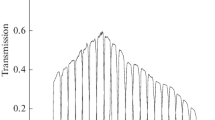We report the results of a study of the distribution of galaxies in the projection along the radius (\(R \leqslant 3{{R}_{{200{\text{c}}}}}\)) for 157 groups and clusters of galaxies in the local Universe (0.01 < \(z\) < 0.10) with line-of-sight velocity dispersions 200 < \(\sigma \) < 1100 km s–1. We introduce a new observed boundary for the halos of clusters of galaxies, which we identify with the splashback radius \({{R}_{{{\text{sp}}}}}\). We also identified the core of groups/clusters of galaxies with the radius \({{R}_{{\text{c}}}}\). These radii are determined by the observed integrated distribution of the number of galaxies as a function of squared angular radius from the center of the group/cluster, which (usually) coincides with the brightest galaxy. We found for the entire sample that the boundary of dark matter \({{R}_{{{\text{sp}}}}}\) for groups/clusters of galaxies is proportional to the radius \({{R}_{{{\text{200}}}}}\) of the virialized region. We measured the mean radius \(\langle {{R}_{{{\text{sp}}}}}\rangle = 1.14 \pm 0.02\) Mpc for groups of galaxies (\(\sigma \leqslant 400\) km s–1) and \(\langle {{R}_{{{\text{sp}}}}}\rangle = 2.00 \pm 0.07\) Mpc for clusters of galaxies (\(\sigma > 400\) km s–1). The mean ratio of radii is \(\langle {{{{R}_{{{\text{sp}}}}}} \mathord{\left/ {\vphantom {{{{R}_{{{\text{sp}}}}}} {{{R}_{{{\text{200c}}}}}}}} \right. \kern-0em} {{{R}_{{{\text{200c}}}}}}}\rangle = 1.40 \pm 0.02\), or \(\langle {{{{R}_{{{\text{sp}}}}}} \mathord{\left/ {\vphantom {{{{R}_{{{\text{sp}}}}}} {{{R}_{{{\text{200m}}}}}}}} \right. \kern-0em} {{{R}_{{{\text{200m}}}}}}}\rangle = 0.88 \pm 0.02\).







Similar content being viewed by others
Notes
Here \({{R}_{{{\text{200c}}}}}\) (hereafter \({{R}_{{200}}}\)) is the cluster radius inside which the density exceeds the critical density of the Universe by a factor of 200. In our studies is determined by the dispersion of line-of-sight velocities of galaxies in clusters. In simulations another radius—\({{R}_{{{\text{200m}}}}}\)—is often used, inside which the density exceeds the average density of the Universe by a factor of 200.
REFERENCES
S. Adhikari, N. Dalal, and R. T. Chamberlain, J. Cosmology and Astroparticle Physics 11, id. 019 (2014).
S. Adhikari, N. Dalal, and J. Clampitt, J. Cosmology and Astroparticle Physics 07, id. 022 (2016).
M. L. Balogh, J. F. Navarro, and S. L. Morris, Astrophys. J. 540, 113 (2000).
E. Baxter, C. Chang, B. Jain, et al., Astrophys. J. 841, article id. 841 (2017).
P. Busch and S. D. M. White, Monthly Notices Royal Astron. Soc. 470, 4767 (2017).
R. G. Carlberg, H. K. C. Yee, E. Ellingson, et al., Astrophys. J. 485, L13 (1997).
C. Chang, E. Baxter, B. Jain, et al., Astrophys. J. 864, article id. 83 (2018).
O. Contigiani, H. Hoekstra, and Y. M. Bahé, Monthly Notices Royal Astron. Soc. 485, 408 (2019).
B. Diemer and A. V. Kravtsov, Astrophys. J. 789, articleid. 1 (2014).
M. Fong and J. Han, Monthly Notices Royal Astron. Soc. 503, 4250 (2021).
S. P. D. Gill, A. Knebe, and B. K. Gibson, Monthly Notices Royal Astron. Soc. 356, 1327 (2005).
R. J. III Gott, Astrophys. J. 186, 481 (1973).
J. E. Gunn and R. J. III Gott Astrophys. J. 176, 1 (1972).
C. P. Haines, M. J. Pereira, G. P. Smith, et al., Astrophys. J. 806, article id. 101 (2015).
A. I. Kopylov and F. G. Kopylova, Astrophysical Bulletin 70, 243 (2015).
F. G. Kopylova and A. I. Kopylov, Astrophysical Bulletin 71, 257 (2016).
F. G. Kopylova and A. I. Kopylov, Astrophysical Bulletin 72, 363 (2017).
F. G. Kopylova and A. I. Kopylov, Astrophysical Bulletin 73, 267 (2018).
F. G. Kopylova and A. I. Kopylov, Astrophysical Bulletin 74, 365 (2019).
G. A. Mamon, T. Sanchis, E. Salvador-Sole, and J. M. Solanes, Astron. and Astrophys. 414, 445 (2004).
S. More, B. Diemer, and A. V. Kravtsov, Astrophys. J. 810, article id. 36 (2015).
S. More, H. Miyatake, M. Takada, et al., Astrophys. J. 825, article id. 39 (2016).
K. A. Pimbblet, Monthly Notices Royal Astron. Soc. 411, 2637 (2010).
T. Shin, S. Adhikari, E. J. Baxter, et al., Monthly Notices Royal Astron. Soc. 487, 2900 (2019).
K. Umetsu and B. Diemer, Astrophys. J. 836, article id. 231 (2017).
D. Zúrcher and S. More, Astrophys. J. 874, article id. 184 (2019).
ACKNOWLEDGMENTS
This research has made use of the NASA/IPAC Extragalactic Database (NED, http://nedwww.ipac.caltech.edu), which is operated by the Jet Propulsion Laboratory, California Institute of Technology, under contract with the National Aeronautics and Space Administration, Sloan Digital Sky Survey (SDSS, http://www.sdss.org), which is supported by Alfred P. Sloan Foundation, the participant institutes of the SDSS collaboration, National Science Foundation, and the United States Department of Energy and Two Micron All Sky Survey (2MASS, http://www.ipac.caltech.edu/2mass/releases/allsky/).
Author information
Authors and Affiliations
Corresponding author
Ethics declarations
The authors declare that there is no conflict of interest.
Additional information
Translated by A. Dambis
Rights and permissions
About this article
Cite this article
Kopylova, F.G., Kopylov, A.I. Halo Radius (Splashback Radius) of Groups and Clusters of Galaxies on Small Scales. Astrophys. Bull. 77, 347–360 (2022). https://doi.org/10.1134/S199034132204006X
Received:
Revised:
Accepted:
Published:
Issue Date:
DOI: https://doi.org/10.1134/S199034132204006X




